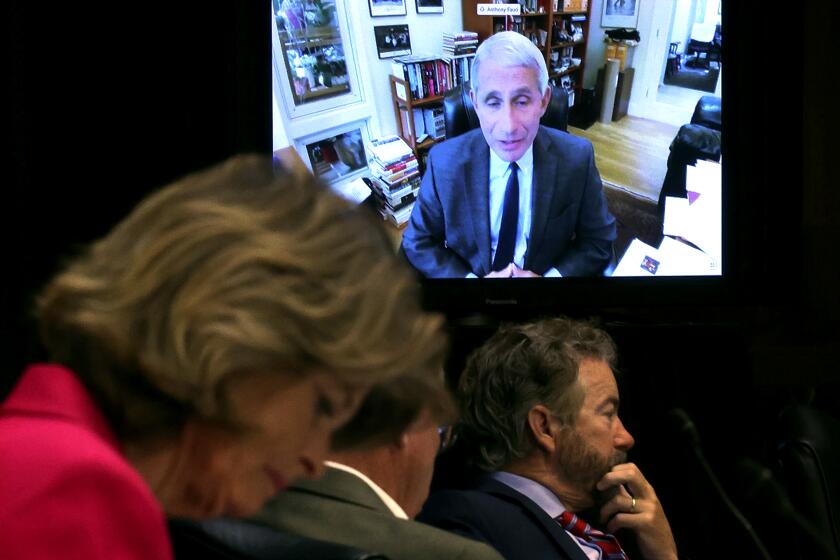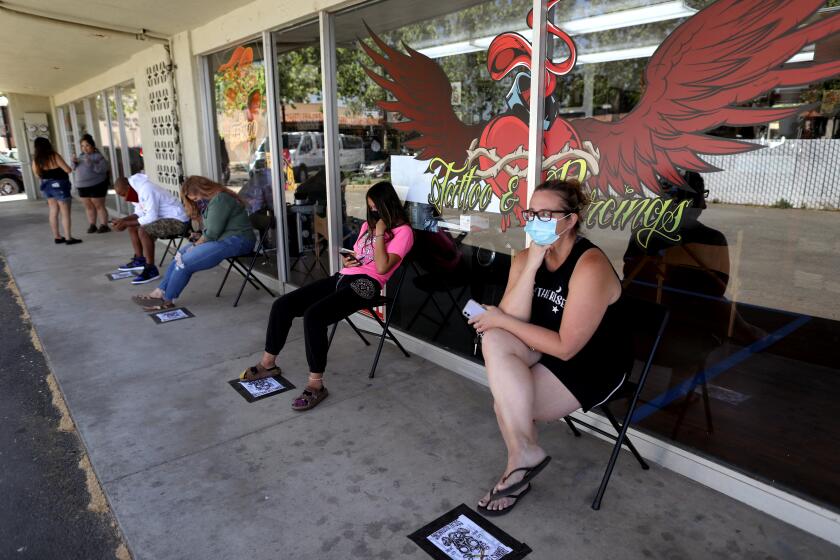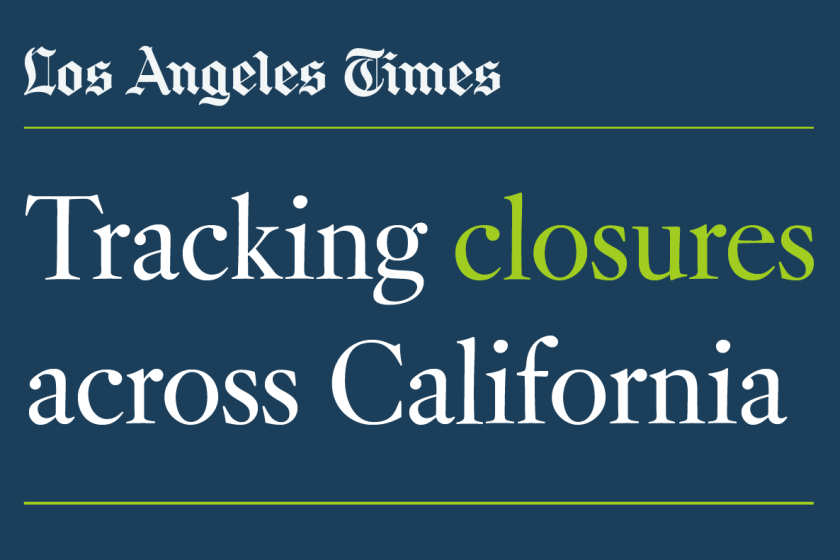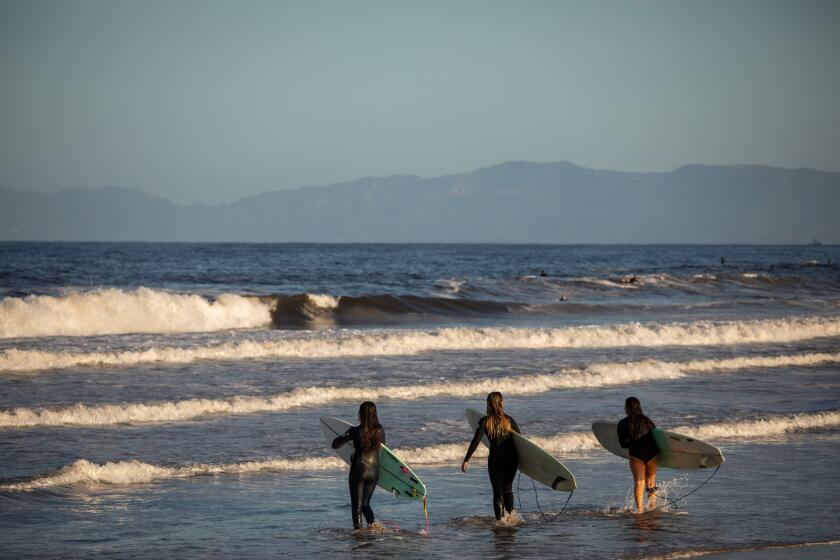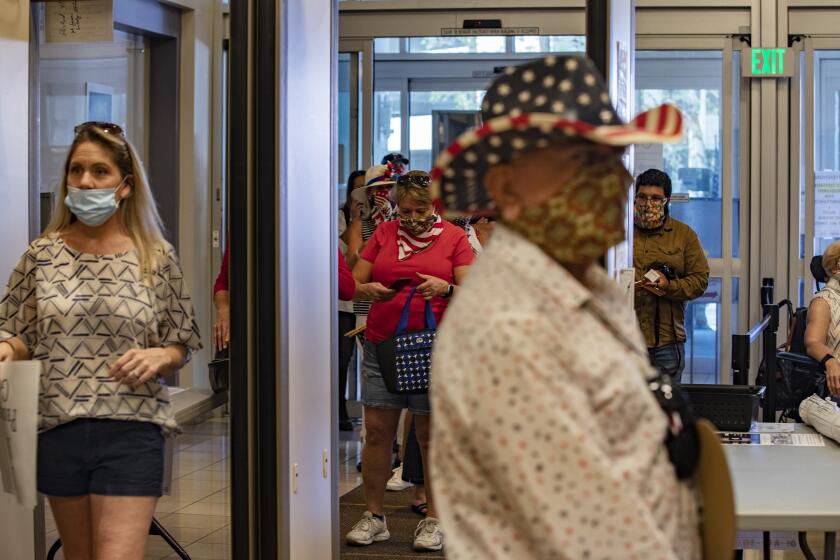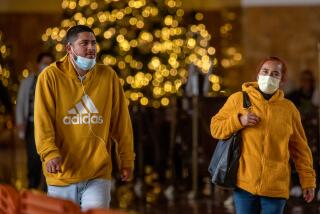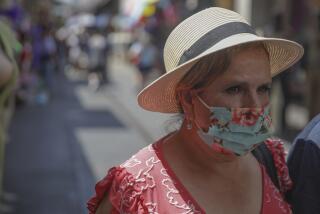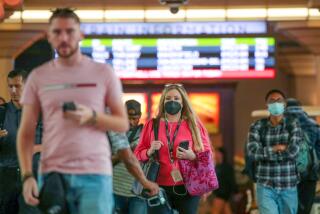L.A. County mandates masks outside as coronavirus deaths top 3,000 in California
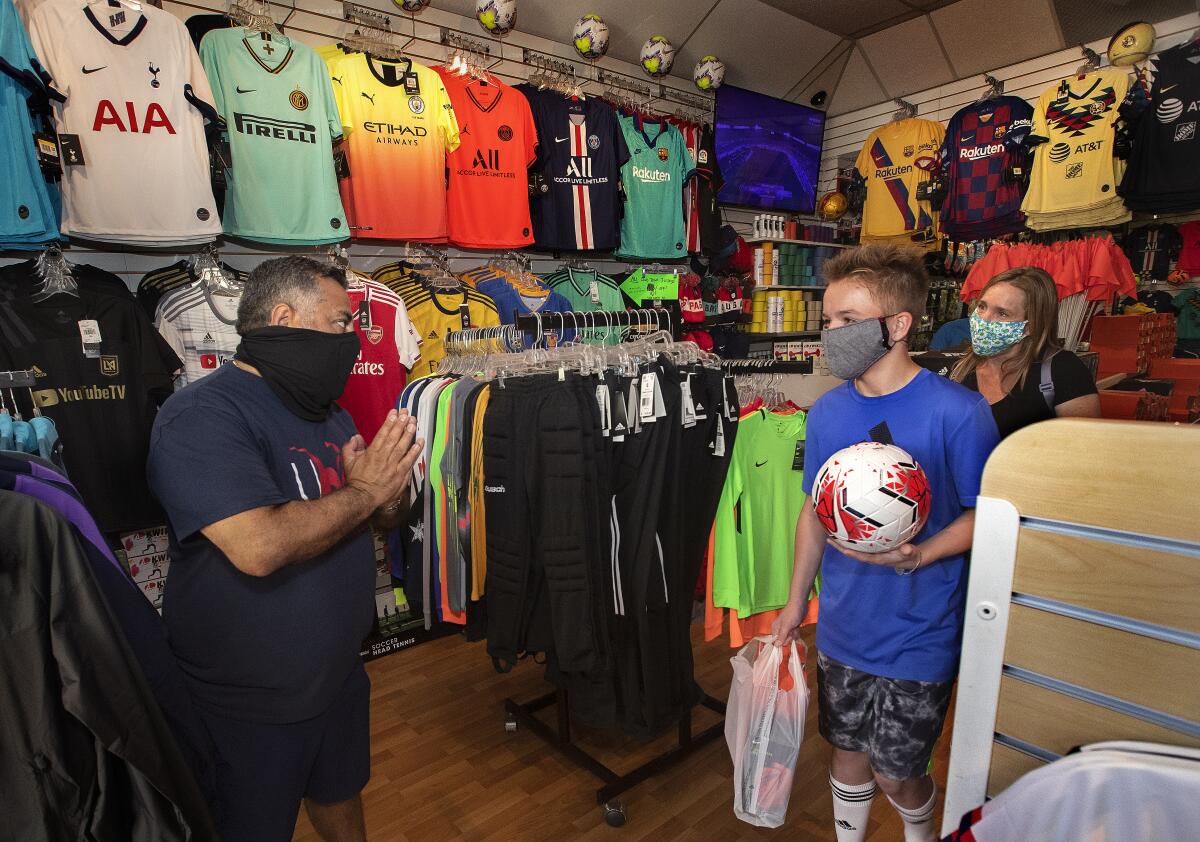
- Share via
In a continuing bid to stymie the spread of the coronavirus, Los Angeles County residents must cover their faces whenever they go outside, a top health official said Thursday.
“Masks are, in fact, mandatory across the entire county when you’re outside of your home, not with members of your household and in any kind of contact with other people,” Public Health Director Barbara Ferrer said.
Even when on a solitary walk or run, Ferrer said “you now need to have a face covering with you, because if you came by other people, you were walking by other people, you tried to go into a grocery store, you absolutely have to have that face covering on.”
Residents should wear a cloth face covering “any time you’re out and there are people around, whether it be at a trailhead or a parking lot or a sidewalk,” she said. Officials also said visitors to the county’s beaches, which opened Wednesday for active recreational use, must cover their faces unless they are in the water.
The more stringent rules come on the heels of a similar order enacted by Los Angeles Mayor Eric Garcetti.
Cloth face coverings, Ferrer said, are a key component in combating COVID-19 because they can help block transmission of respiratory droplets that carry the disease.
The latest maps and charts on the spread of COVID-19 in Los Angeles County, including cases, deaths, closures and restrictions.
That’s particularly important in Los Angeles County, which continues to be a hot spot for the virus in California. Ferrer announced 51 new coronavirus-linked fatalities Thursday, pushing the state’s death toll to more than 3,000.
In all, 1,709 L.A. County residents have died as a result of COVID-19, according to Ferrer.
Ferrer compared that number with the mortality rate for influenza in a typical year, noting that only about 250 people die during flu season.
“You can understand why the mortality rate for COVID-19 is so worrisome because it far exceeds what we’re normally used to seeing with a virus or a communicable disease,” she said.
Ferrer also announced 925 new COVID-19 cases in L.A. County, raising its cumulative total to 35,329 and pushing California’s statewide figure closer to 75,000.
Of the county’s deaths, 865 — about 51% — were people who lived in institutional settings. The “vast majority” of them resided in nursing facilities, Ferrer said.
The former head of the U.S. Food and Drug Administration says we should get back to work “differently” to keep outbreaks at bay.
“I’m sad to report that this is the first day that we’ve had to note that more than half of all the people who have died from COVID-19 in L.A. County were residing in institutional settings,” she said.
The total number of confirmed cases in those settings is now at 8,783.
Despite the steady increase in the number of COVID-19 infections and fatalities, the state is starting to cautiously lift restrictions put in place to stem the spread of the coronavirus.
The result has been a pandemic patchwork.
Some businesses have been allowed to open while others remain shuttered. A few areas are requiring masks to be worn anytime residents leave their homes. More than a dozen counties are moving toward something resembling normalcy, while others are firmly standing by stay-at-home orders and other coronavirus restrictions.
As California moves into what Gov. Gavin Newsom has deemed Phase 2 of the state’s reopening plan, it has become possible for counties to go further in terms of opening businesses, provided they meet certain criteria.
Only counties that meet state standards for testing and reducing coronavirus cases may allow dining in restaurants and and shopping in person.
Newsom said this week that restaurants and shopping malls can reopen in counties that meet state standards for testing and reductions in coronavirus cases, but all businesses will have to abide by state guidelines for physical distancing and cleaning regimens. Counties also must have adequate testing and hospital capacity and the ability to trace those who have been in contact with ill people.
Before businesses can reopen, a county must complete a risk assessment and develop protection plans that include training employees in how to limit the spread of the virus, providing screenings of workers and establishing disinfection protocols and physical distancing guidelines.
Although the state’s phased reopening started Friday — with clothing stores, sporting goods retailers, bookstores, music stores, toy stores and florists able to provide curbside service — only more rural, less-populated reaches of the state have successfully petitioned to open faster.
More than a third of California’s 58 counties have certified to the state that they have contained the spread of COVID-19, which allows them to reopen restaurants to dine-in service, as well as shopping malls and other businesses.
As of Thursday afternoon, the state said 20 counties had met conditions to reopen more fully: Amador, Butte, Calaveras, Colusa, El Dorado, Glenn, Humboldt, Lassen, Nevada, Mariposa, Placer, Plumas, San Benito, Shasta, Sierra, Siskiyou, Sutter, Tehama, Tuolumne and Yuba.
The counties, which have attested to meeting state standards for containment, are mostly in rural areas of Northern California with small populations. They represent about 4.5% of the state’s population and do not include urban centers such as Los Angeles and San Francisco that remain largely on lockdown.
To contain the spread of COVID-19, parks, restaurants and stores are slowly reopening.
“As of today, the attestations are up and those counties … are moving deeper into the second phase of reopening large sectors of their economy,” Newsom said during a news conference where he announced a revised state budget in response to the pandemic.
The state is continuing talks with other counties that are trying to meet state standards for testing, hospital availability and numbers of cases.
“We are doing what we can to move forward as we committed in that space,” Newsom said.
The benchmarks necessary to reopen remain out of reach for most urban areas. A Times data analysis last week found that 95% of Californians live in counties that don’t meet two key thresholds: a cessation of COVID-19 deaths in the previous 14 days and no more than one case per 10,000 residents in that same period.
In Los Angeles County, which remains the hotbed of California’s coronavirus outbreak, officials are allowing the limited reopening of thousands more retail shops and manufacturing companies, even while extending the local stay-at-home order indefinitely.
“Let me be clear: Businesses must comply with the county’s guidelines in order to keep our employees and customers safe,” county Supervisor Hilda Solis said Thursday. “Reopening can’t mean jeopardizing the progress we’ve made so far.”
Coronavirus: Health officials in L.A. County say parts of the stay-at-home order could last well into summer.
Even as additional businesses open and county officials relax restrictions on outdoor recreational areas, Ferrer said it’s important for residents to remain vigilant and cautious, especially if they have underlying health conditions.
“Please take a moment to try to make sure that you will be able to continue to stay at home as much as possible,” she said.
L.A. Mayor Eric Garcetti also announced Wednesday evening that all Angelenos, except for small children and those with certain disabilities, would be required to wear face coverings outside their homes. Similar exceptions are in place countywide.
Other urban Southern California counties — Orange, Riverside, San Bernardino and San Diego — are working to forge a coalition to jointly lobby Newsom so they can further reopen their local economies.
Officials in Orange County, which will unveil a potential road map for lifting some coronavirus-related restrictions Thursday, have said the state’s criteria for more fully reopening are overly burdensome and unrealistic for urbanized areas.
“We are doing this because, even though the governor has said one size doesn’t fit all, he is very much imposing a one-size-fits-all response,” Orange County Supervisor Don Wagner said Tuesday.
The Riverside County Board of Supervisors has voted unanimously to adopt an alternative plan to reopen the local economy.
Thursday, Orange County confirmed 229 additional coronavirus cases, its highest daily case count since the start of the pandemic. The total broke the previous day’s record of 156 new cases.
The growing numbers aren’t only because of an increase in testing, Dr. Clayton Chau, director of the Orange County Health Care Agency, said during a news conference. More people have become seriously ill from the virus in recent weeks, Chau said, including many in nursing homes and jails. Those populations also account for many of those hospitalized with COVID-19. There are 227 people currently hospitalized, and 79 of those individuals are in intensive care.
The San Francisco Bay Area, where local health officers have largely worked in concert throughout the coronavirus outbreak, is also starting to see some divergence.
At least three counties — San Francisco, San Mateo and Marin — plan to incrementally ease their social distancing restrictions starting Monday. Santa Clara County has said it has no immediate plans to do so.
Newsom has hinted that the statewide guidelines will be modified to allow larger counties hit hardest by the outbreak to reopen more broadly.
“Over the next few weeks, we’ll be making subsequent announcements for the entire state, not just those that meet those more restrictive criteria,” he said Friday.
Times staff writers Colleen Shalby, Susanne Rust, Maura Dolan, Rong-Gong Lin II, Kailyn Brown and Sarah Parvini contributed to this report.
More to Read
Sign up for Essential California
The most important California stories and recommendations in your inbox every morning.
You may occasionally receive promotional content from the Los Angeles Times.

